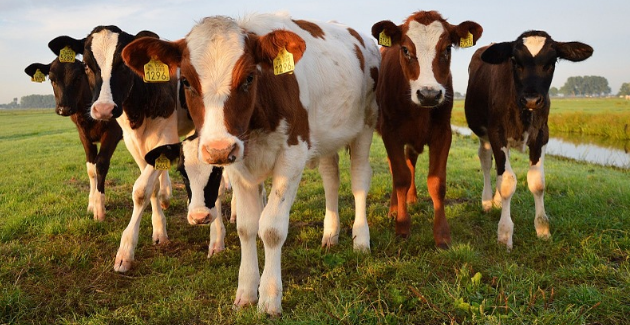Antibiotic Resistance and the Global Food Chain

World Veterinary Day on 29 April draws attention to the role of farmed animals in spreading antimicrobial resistance and diminishing the effectiveness of antibiotics. Large global investors are leading efforts to eliminate the risk, but governments must catch up.
The danger of antibiotic resistance, also referred to as antimicrobial resistance, is headlining 2017 World Veterinary Day. In addition to media coverage of cuddly pets, the day set aside to showcase the work of veterinarians helps to highlight their role in prescribing and selling antibiotics as inputs to feed for food-producing animals and pets.
Antimicrobial resistance can undermine the effectiveness of antibiotics necessary to treat food poisoning. Its presence in the food we consume can also alter the bacteria living in our gut. The United Nations Food and Agriculture Organization (FAO) has already expressed concern over mounting evidence that global food production systems may be major conduits for antibiotic resistance. Key players in the global food industry are also becoming aware of this problem.
Consumers, however, are relatively ignorant of the issue. While they may be aware that animal-based foods can be contaminated with E.coli or salmonella, for example, consumers are much less familiar with the concept that such bacteria may also be antibiotic resistant. Nor are consumers generally aware that most governments have not set in place systematic regulatory mechanisms to detect antibiotic resistance entering the food consumption chain at the border or in domestically produced food.
Testing that is undertaken for antimicrobial resistance in food tends to be partial, random or conducted by academic researchers and industry producers. Laboratory facilities and funding for comprehensive testing are lacking. Given that international institutions such as the FAO carefully vet their scientific reports and tend not to overstate food security issues, one would expect to see governments taking steps to reassure consumers that they are actively and openly testing food for the presence of antibiotic resistance. Currently, governments test for antibiotic residues in food, but this is not a test for resistance.
Making resistance a priority
Health and research experts already have evidence of excessive use of antibiotics, and of antibiotic resistance being found in animals, fish, fertilisers, agricultural outputs, water, pets and food. Shockingly, resistance to colistin, a last-line antibiotic, has been found in more than 30 countries. US reports and as yet unexplained evidence from Italy link food to the spread of resistance to colistin.
Codex, the joint FAO-WHO food standards program, is in the process of revising its decade-old advice on antibiotic resistance but is not expected to complete this work before 2020. Efforts at the national level to track antimicrobial resistance contamination in food have been slow. Systematic testing policies so far have been mostly rhetorical, with patchy implementation across all sectors. This is unacceptable given ever-increasing reliance on the global food chain and the inevitable spread of the problem. Lack of government leadership will corrode public confidence and could trigger a consumer backlash that damages key sectors of the economy.
Flexing financial muscle
Significant global investors recognise and are responding to the risks presented by antibiotic resistance. Under the banner of the Farm Animal Investment Risk & Return (FAIRR) Initiative, 54 influential global asset managers warned large global food and restaurant corporations in 2016 to take account of antibiotic resistance and alter their food supply chain accordingly. The message was clear: stop the use of antibiotics for non-therapeutic purposes and place make antibiotics critical for human health off limits. This coalition has further expanded its coverage of food industry investors, now numbering 71 and representing approximately US$2 trillion (AU$2.66 trillion) in assets.
The business rationale applied by these global asset managers, explained in the FAIRR Initiative’s report, has helped to minimise and in some cases eliminate the use of antibiotics in food-producing animals in the markets they control. Their risk calculations provide a useful guide for competing food industries. This market-based strategy can deliver additional positive outcomes, including price premiums from selling antibiotic free food. But this special segmented market, welcome as it is, will not deliver the necessary transformation to limit the spread of antimicrobial resistance through the food chain. Nor will rational economic arguments attached to notions of consumer choice be sufficient. The food supply chain is much more complex and antimicrobial resistance will continue to spread despite enlightened best practice.
This concept of an antimicrobial resistance-induced financial risk nonethless could be a political game-changer given the economic importance of the food service industry in Western countries. Companies could find themselves with ‘stranded assets’ if strategic analysis identifies sustained consumer backlash. Brand damage can be significant when the media focus on antibiotic resistance events. Live debates on globalisation and ‘taking back control’ would also come into play if consumers cannot trust governments to ensure safe food.
Governance and national interest
Consumers’ knee-jerk reactions can unintentionally damage many other food producers, particularly in developing countries where some food production has become as dependent on antibiotics as large farms in the United States. To avoid damage to economic development, creative alternatives and policy interventions must be introduced. Relying on consumer ignorance is not a solution.
Governments have been slow to systematically collect the basic antimicrobial resistance data required for policy development. This raises governance and national interest questions, especially for governments that prefer evidence-based policy over a safety focused precautionary policy framework.
Trade facilitation policies promoting self-regulation and cutting red-tape undoubtedly deliver efficiency and financial gains for the private sector. But antibiotics used in food production and any consequent development of antibiotic resistance is now a health security issue. Only governments have the legal capacity to implement regulations around complex, integrated food supply chains.
Although politically complex, rules governing trade in food can be recalibrated, so trade obligations are no excuse. The political and economic cost-benefit matrix for the current model of food production has been fundamentally changed by the looming antimicrobial resistance crisis. Business as usual is unsustainable.
Anna George is currently an adjunct professor with Murdoch University and an associate fellow with the Chatham House Centre for Global Health Security. She is a former Australian ambassador.
This article is published under a Creative Commons Licence and may be republished with attribution.





